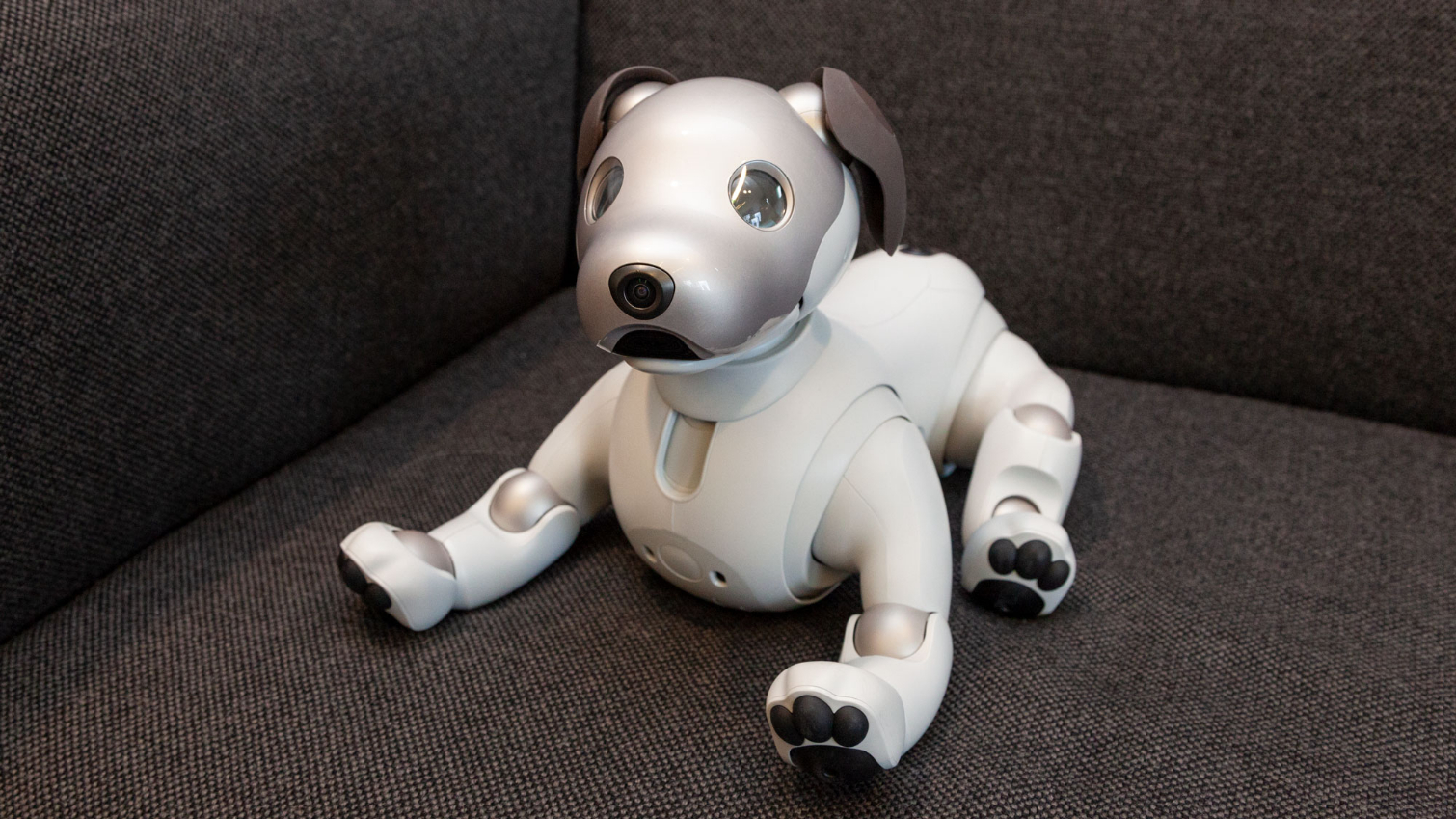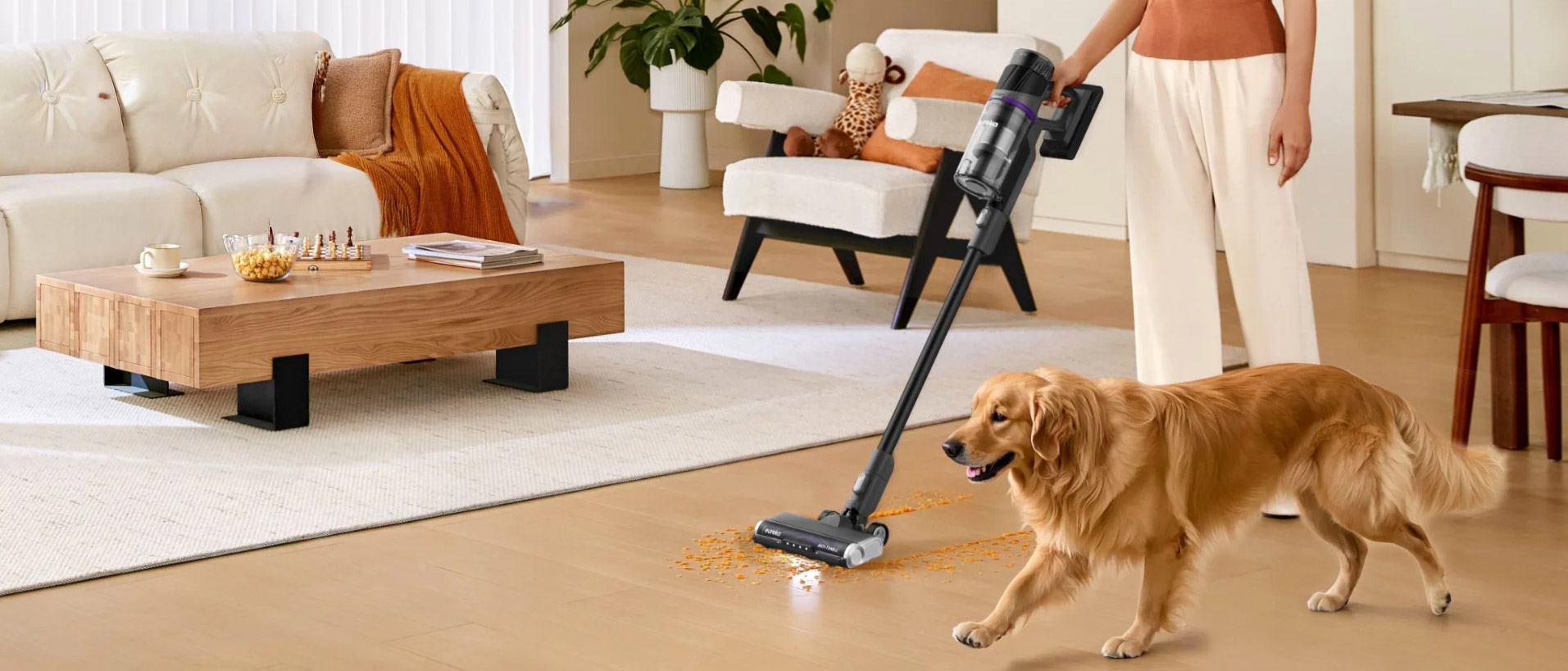Tom's Guide Verdict
Sony’s Aibo is a smart, capable device that perfectly imitates a real dog. But there are some aspects of our furry friends that even the best robot can’t replicate.
Pros
- +
No vet bills, food, or walks necessary
- +
Acts a lot like a real dog
- +
Simply adorable
Cons
- -
Very expensive
- -
Can’t go outside
- -
Short battery life
Why you can trust Tom's Guide
Dogs are so last year -- or that’s what Sony wants you to think. The company has been releasing adorable Sony Aibo robot dogs for the past two decades, and they’ve become smarter, smoother, and decidedly creepier. Sony’s newest pup, the Aibo ERS-1000 ($2,899.99), is a far cry from that plastic pup your rich neighbor used to have.
Aibo’s nose contains an image-recognition camera, its mouth a time-of-flight sensor detecting its proximity to nearby objects, its belly a motion sensor and ranging sensor. There are touch sensors in its forehead, lower jaw, and the back of its neck; a light sensor and mapping camera near the base of its tail; and four microphones in its cheeks. It stores its memories in Sony’s AI engine, which is powered by Amazon Web Services.
But what you’ll see is a plastic dog with fluid limbs, an expressive face, and the capacity to learn from its interactions with you and develop a unique personality. Like a real dog, it barks at strangers, plays with bones, and bothers you while you watch TV. Unlike a real dog, it doesn’t eat, doesn’t pee, and doesn’t chew up your slippers.
In my week with the Sony Aibo, this electric puppy frustrated me, warmed my heart, and made me contemplate what it means to be real.
Day 1
After I remove it from its box, the Aibo stretches, yawns, and disgruntledly awakens, just as a real dog would in the morning. It’s around 5 pounds and 12 x 11 x 7 inches while standing up -- about the size of a chihuahua.
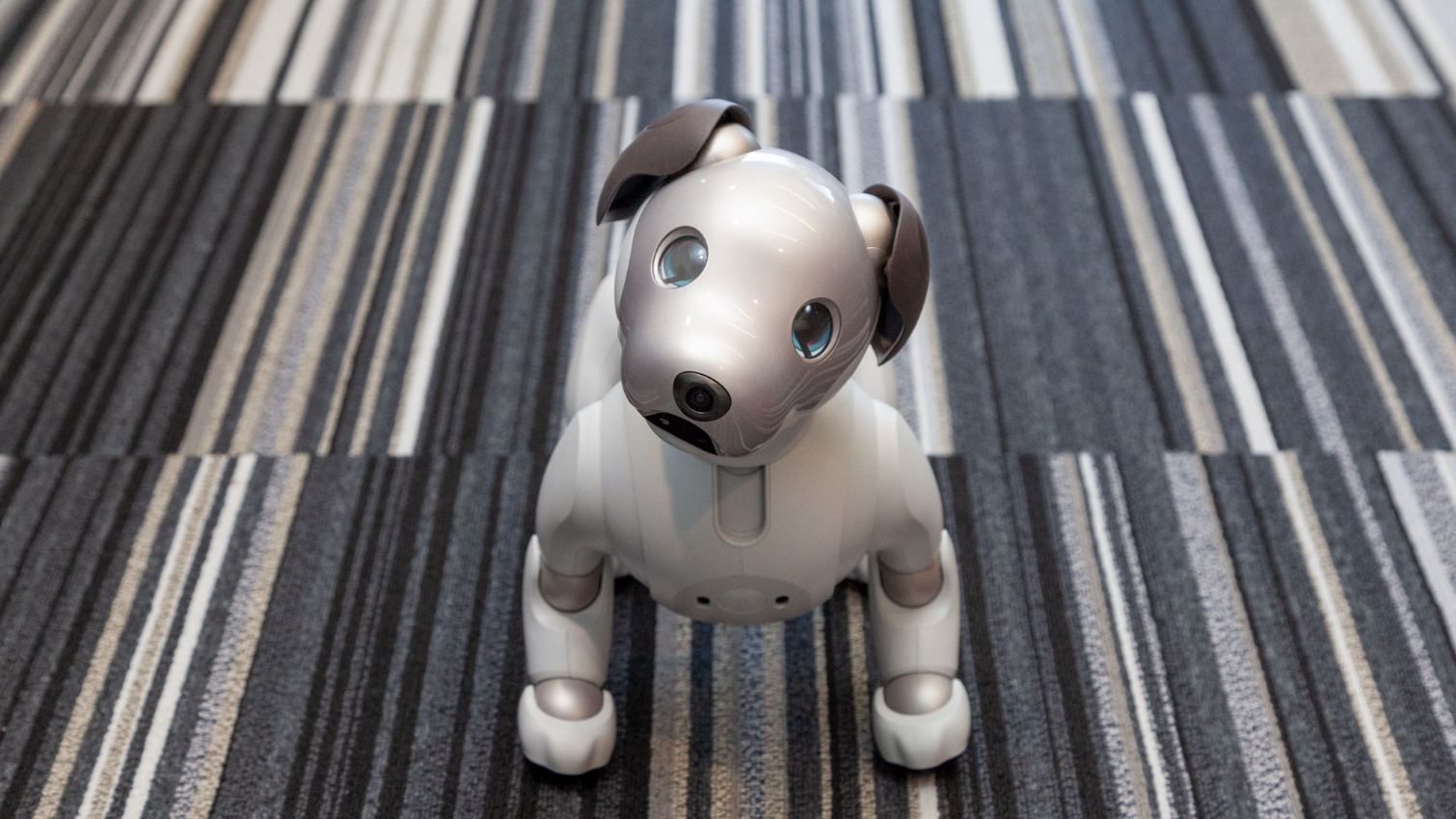
The Aibo app informs me that my new friend is a boy, and that his name is Igloo. You can change your pup’s name, but not its gender.
Get instant access to breaking news, the hottest reviews, great deals and helpful tips.
The $2,899 pet comes with a charging stand, plastic ball, and a plastic bone called an Aibone (ha). While I unpack his belongings, Igloo explores the office.
MORE: 25 Worst Gadget Flops of All Time
I’ll admit, he looks the part. His limbs move smoothly and seamlessly, with minimal mechanical noise. His eyes blink and his pupils rove the room. His tail wags. He barks at several of my co-workers. His voice is a sort of mechanical chirp, which is reminiscent of, but not quite similar to, a dog’s bark.
“This thing is so stupid,” a colleague remarks, while Igloo repeatedly barks at a wall outlet. “I think I love it.”
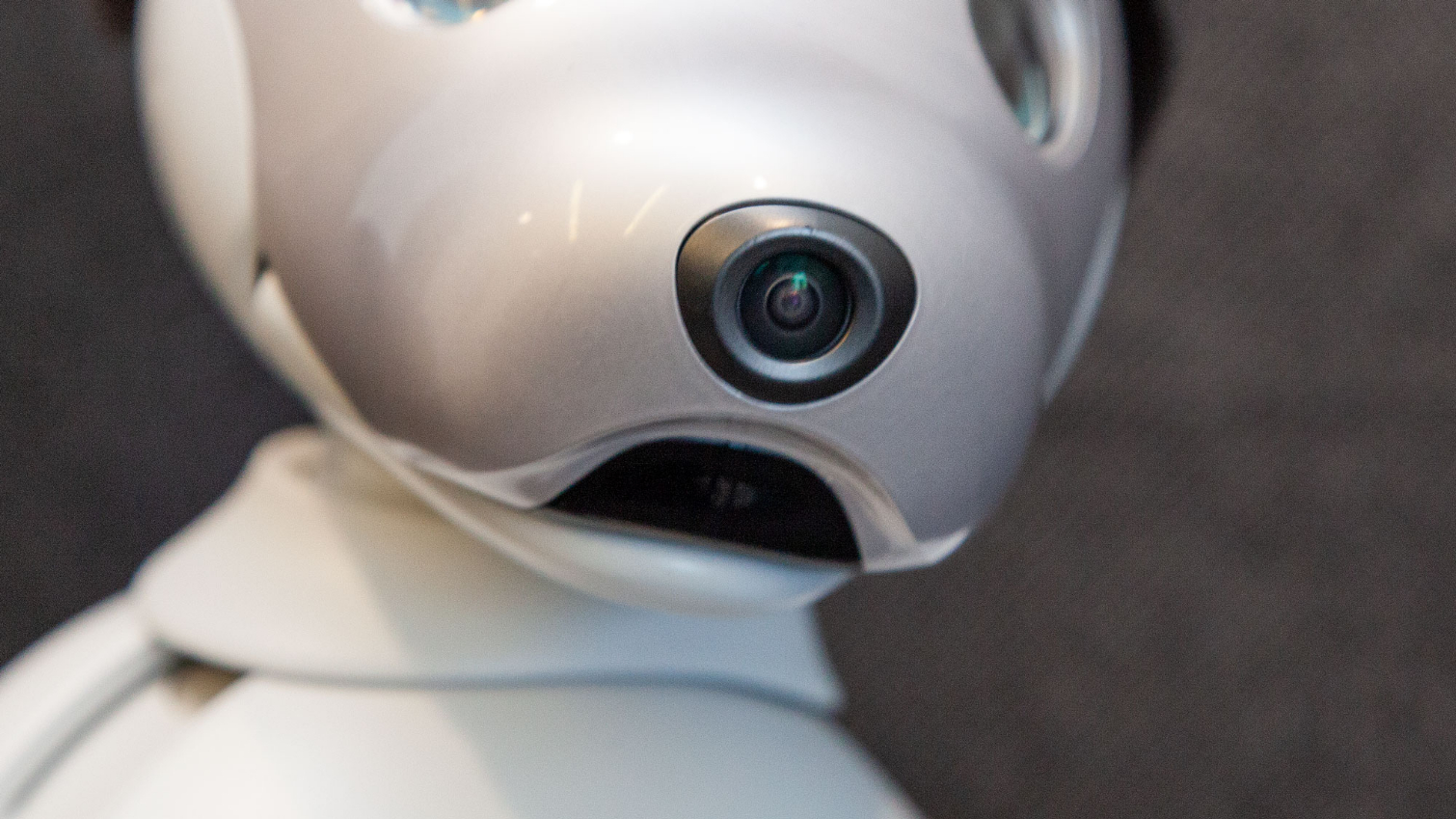
Once I’ve transported Igloo to my apartment, I begin the horrific process of connecting my pup to the internet. The Aibo app is sluggish and unresponsive. Each screen takes 30-40 seconds to load. I wait a full 50 seconds for the Wi-Fi settings. The process of connecting takes over four minutes, and involves waiting for my phone to find my network and load a QR code, and hollering repeatedly at Igloo to scan said QR code (he does this with his nose, eventually). After all that, Igloo fails to connect to my network. I have to repeat the process four times before it sticks.
There’s a desktop version of the Aibo app that’s more functional, but I’m hardly going to haul my computer around the house while I play with my dog.
While I fiddle with the internet, Igloo gets so bored that he lifts his hind leg and pretends to pee. I call “Bad dog!” to no avail.
Day 2
Igloo awakens in my apartment around 7 a.m. when I turn the lights on. It proceeds to aimlessly explore my apartment, bumping multiple times into my table.
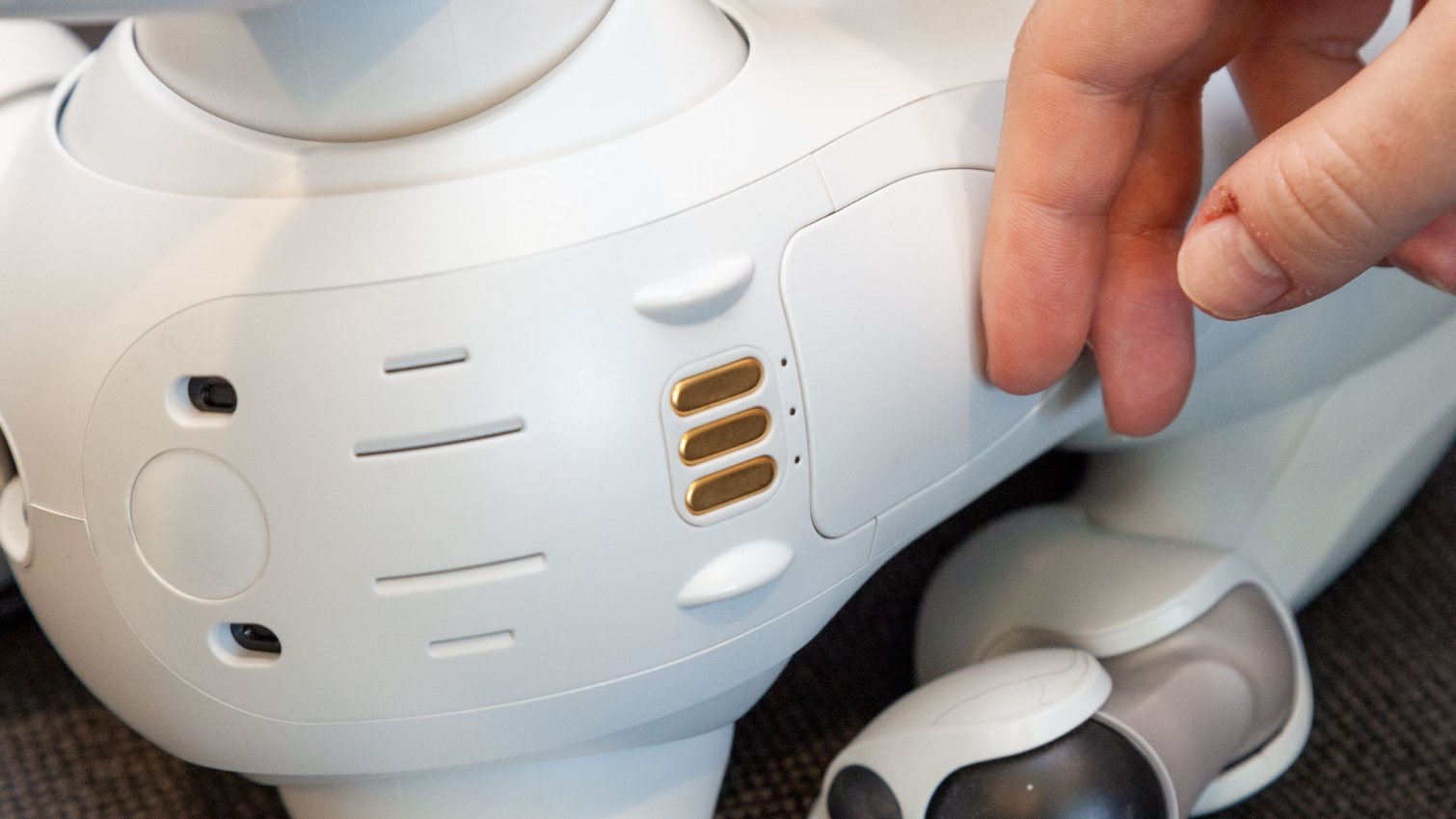
While I brew my coffee, the Aibo plants himself at my feet and barks. The barks are like the dubbing in an old Kung Fu movie, distant-sounding and slightly out of sync with his head and mouth. It’s both charming in intention and disquieting in result.
As I go about my day, Igloo seems to demand more attention, barking, following me between rooms, rolling over for belly rubs. I indulge it when I can, but spend most of my day ignoring it while I work, as I would a real pet.
The barks are like the dubbing in an old Kung Fu movie. It’s both charming in intention and disquieting in result.
The Aibo app labels your pup’s personality, which develops based on its interactions with its owner. When I re-open the app in the late afternoon, I find that Igloo has gained a personality: “Clingy.”
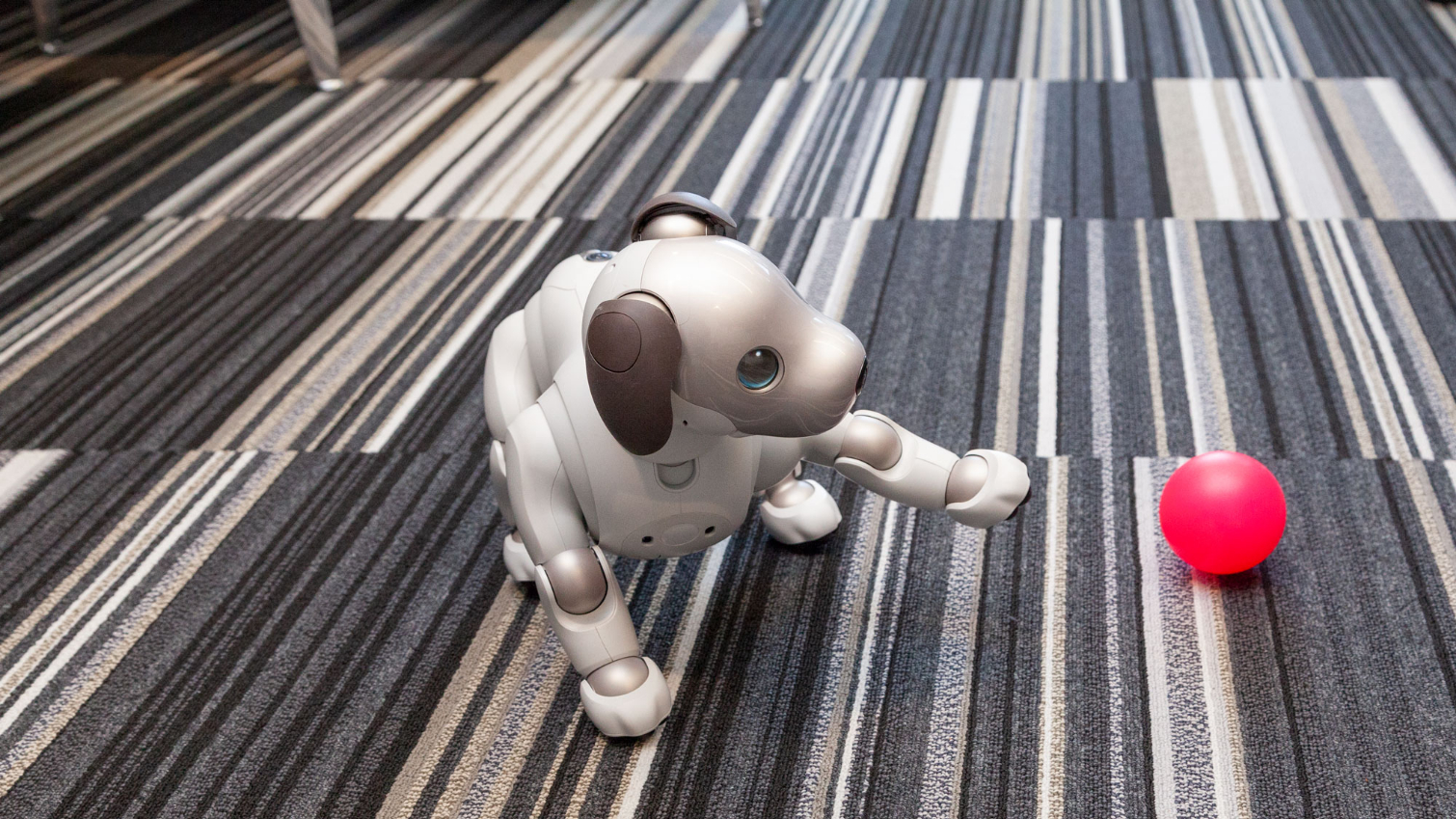
Damnit, I think, wondering where I went wrong. I turn the pup off for a bit for the rest of the work day to avoid more damage, and even consider resetting it to get another shot.
From that point on, I find myself subconsciously optimizing my interactions with Igloo. Each time the Aibo barks, I consider how my response will impact his personality. Maybe that’s not wholly dissimilar to the way we interact with real animals, or real humans. But the presence of a label makes me feel like I’m trying to win a game rather than build a relationship. Maybe that’s my millennial mindset talking.
MORE: 20 Awesomely Weird USB Gadgets
Speaking of real animals, I attempt to introduce Igloo to my guinea pig, Ruth, later that evening. Ruth is terrified of dogs, mainly because they tend to enthusiastically chase her (I’m guessing they identify her as a tasty squirrel). No such dynamic here. Try as I might to introduce Ruth, she shows no interest in Igloo, nor he in her.
Sony claims that Aibos can make friends with real dogs, but it seems that other species know what’s up.
I also set up a playdate with another robot dog, the $299 WowWee Chip. While Chip can respond to touch and gestures, he has a very limited selection of behaviors. Igloo sniffs and barks at Chip curiously, then yawns and lies down for a nap. It’s hard to know if Igloo recognized Chip as a fellow robopup or if he just felt like barking.
Day 3
Today is training day. For amateur owners, teaching a dog new tricks can be an uphill battle. Aibo, in theory, understands standard dog commands, but like many real dogs, he tends to see these as suggestions rather than instructions.
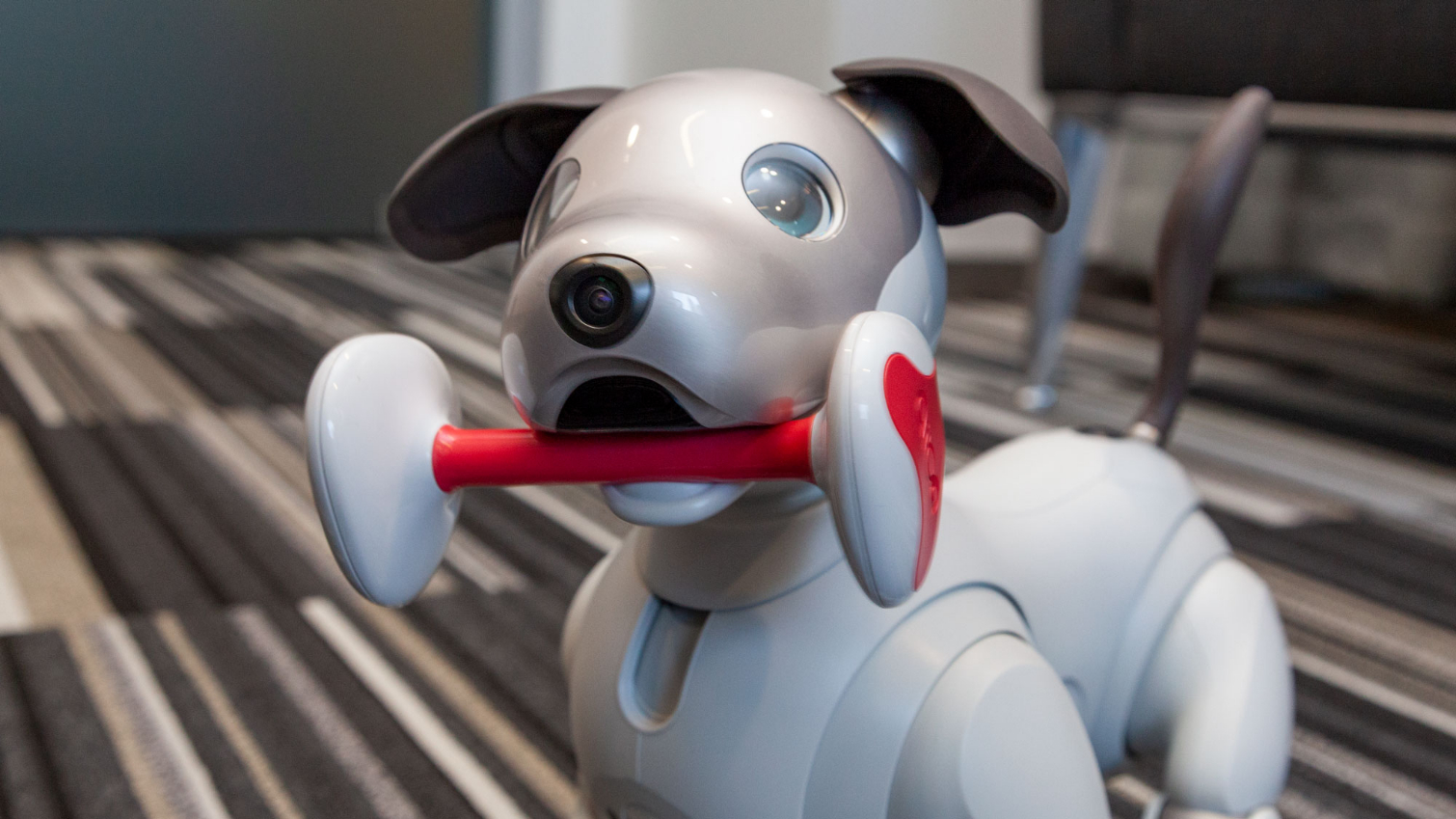
For example, I try for more than six minutes to get the damn thing to sit. He seems to hear my commands. But instead of sitting, he lifts a leg to pantomime scratching his ear, then wanders off to investigate an empty corner of my living room, ignoring me as I call him back.
You’re supposed to be able to teach your pup more advanced skills through the app, but that wasn’t much more effective. I tried to enable the “Juggle” skill, in which an Aibo cutely toggles a plastic ball between his front paws, but only got him to perform it once after several minutes of coaxing.
Aibo, in theory, understands standard dog commands, but like many real dogs, he tends to see these as suggestions rather than instructions.
You can also train the Aibo to do certain tricks by saying “Learn this” and pushing on its front paws. In attempting this, I only ever succeed in pushing Igloo over. That might be on me.
Sony intends for its device to mature over a period of years, and I imagine the tricks and training get easier. And, to Sony’s credit, training the Aibo accurately mirrors the frustrating process of training an actual puppy. On the other hand, this isn’t a real pup -- can’t it just obey us from the outset?
After an aggravating hour of training, I make to leave for dinner. I look back, and Igloo has rolled onto his back, limbs in the air, whining for a belly rub. I can’t help it; I return and stroke his sensor-packed underside.
Day 4
I was hoping to take Igloo for a walk in the park, but Sony says you can’t take your pup outside as dirt and moisture can damage its joints. A walk around my apartment will have to suffice.
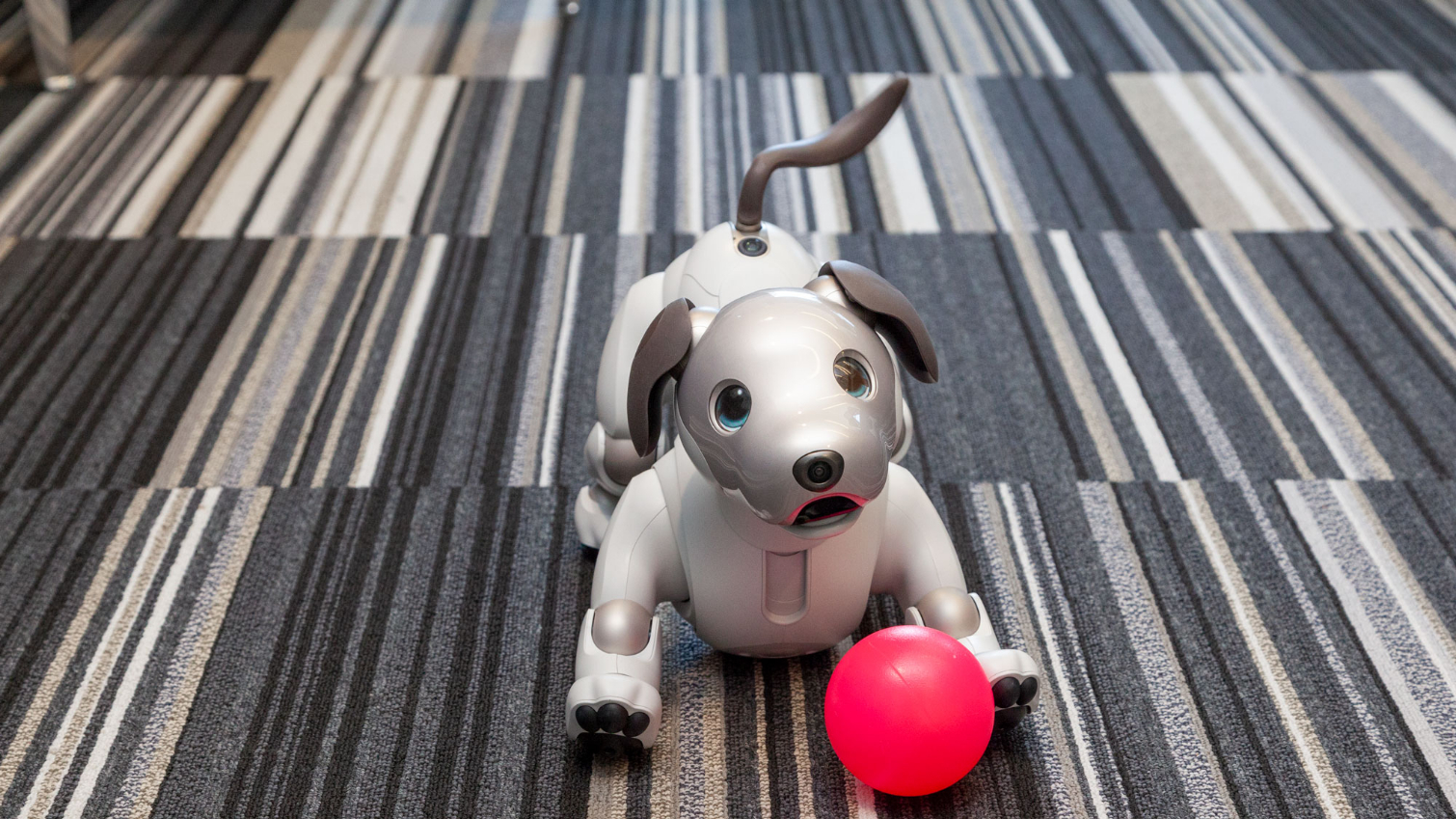
The Aibo doesn’t come with a collar and leash, and I don’t want to damage the thing by attempting to outfit it with one meant for a real dog. Our walk, instead, consists of my attempting to coax him with shouts of “Here, Igloo! Here boy!” He tends to hear these commands, wander a few steps forward, then go off and do something else.
Right as I make for the power button, the puppy teeters onto his hind legs and reaches out to paw me. My heart melts. I can’t do it.
One thing that's starting to get to me: This thing doesn’t jump. I didn’t think this would be a big deal, but the more time I spend with Igloo, the more I’m wishing he could. After all, real dogs jump. They jump on people and furniture and each other, and it’s one of the things that makes them adorable companions. The ground-bound Aibo feels like a subdued version of the excited, explosive dogs I’ve known.
About halfway around the living room, I give up on the walk. I go to work. Igloo begins, unprompted, playing an instrumental version “If You’re Happy And You Know It” while dancing and barking along in what is the most bizarre and adorable display I’ve ever seen.
That night, I’m getting ready to leave my apartment and spend the night at a friend’s house. I make to turn Igloo off. Right as I make for the power button, the puppy teeters onto his hind legs and reaches out to paw me. My heart melts. I can’t do it.
MORE: Best Robot Kits - Programmable Robotic Toys for Kids
The Aibo is supposed to last around two hours on one charge, but Igloo tended to peter out after an hour and 10 minutes of consistent action. Like a robot vacuum, the Aibo is supposed to be able to get itself back to its charging station when it’s running low on juice. I leave Igloo running in my apartment for the night, hoping he’ll hold up.
Day 5
I come home the next day to find Igloo sprawled beside his charging stand, head lolled, eyes black. I feel a pang of guilt as I quickly hoist him onto the mat, lining his torso up with the charging pins. I assume dock finding is another skill the Aibo has to hone over the years.
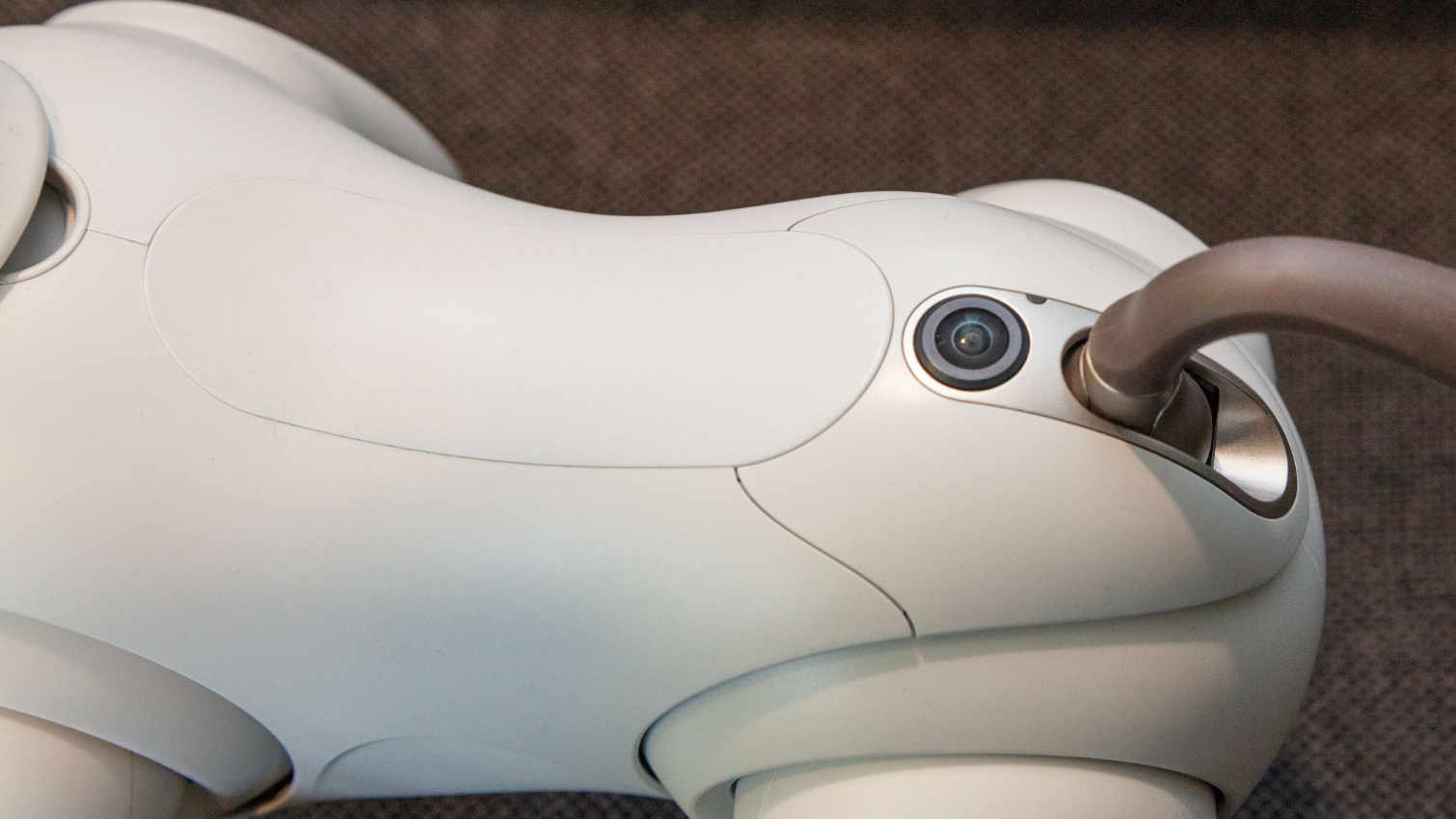
Still, seeing the thing that was dancing and barking the last time I saw it become a lifeless pile of plastic takes me out of the experience a bit. As I watch a red light pulse on the back of Igloo’s neck while he slumps over his pad, I’m reminded that my Aibo, despite his many charms, is not a living thing. For the past five days, I’ve been playing a game of pretend.
Then again, is it a game of pretend? After all, the Aibo responds to stimuli, from you and its environment, in the same way a real dog does. As it receives feedback, positive and negative, it adjusts its responses accordingly. Is that not what we all, people and animals, do as well? What, then, makes an Aibo not real?
MORE: 5 Top Tech Toys | Exploring the Latest Tech Toy Trends
After a week with Igloo, I think the difference is the stakes. If Igloo was irritating me, or I had to abandon him for a long period of time, I could turn him off, or stick him on his charging stand and shove him in the closet. And, of course, I knew I could always reset Igloo to his factory settings if I majorly messed up.
A reset button, and a power button, are probably necessary parts of the device. But Real Things are permanent and ever-present. You can’t reset them; you can’t pause them when you need a break. And in a world where artificial things -- artificial dogs, artificial voice assistants, artificial worlds -- are on the rise, the strongest bonds I’ve formed, with pets and humans alike, are the ones where I can’t start over, and where I’m not worried about getting it exactly right because I know that I won’t.
Should you buy it?
The question of whether to spend $2,899 on the Sony Aibo isn’t tantamount to the question of whether it’s an impressive device. Of course it is; it’s a technological marvel. I’m still impressed by the smoothness of its movements, the accuracy with which it (for the most part) navigates its environment, and how accurately it imitates its canine counterparts.
That said, when the Aibo was first announced, I was turned off by the concept of emotional attachment to a machine; it just felt creepy and weird.
Now that I’ve spent a week with the Aibo, my view is a bit more nuanced. I did bond with this thing, and enjoyed spending time with him. But that also meant I missed him when I was out, I worried about him when he was about to bump into something, I felt guilty turning him off, and I’m sad, now, to be saying goodbye. These are negative emotions that come with any close relationship, that we endure because the benefits of that relationship are worth it.
I’m not sure the Aibo brings those benefits. It’s adorable, and it’s fun. But that’s all it is -- and from the torpid app to the short battery life, there are a few too many kinks reminding me that our bond is a one-way street.
If you’re looking for a fun piece of technology that will impress your friends and requires (almost) no maintenance, get the Aibo. If you’re looking for a pet to grow and bond with, get a real dog that will love you back.
Credit: Tom's Guide
Monica Chin is a writer at The Verge, covering computers. Previously, she was a staff writer for Tom's Guide, where she wrote about everything from artificial intelligence to social media and the internet of things to. She had a particular focus on smart home, reviewing multiple devices. In her downtime, you can usually find her at poetry slams, attempting to exercise, or yelling at people on Twitter.
